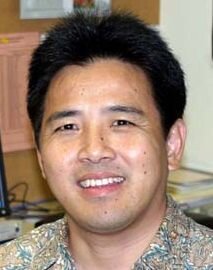
Contact Information
Urbana, IL 61801
Research Areas
Research Description
Evolution of primitive sex chromosomes, genome structure of papaya, sugarcane, coffee and pineapple
Sex expression in papaya (Carica papaya L.; Family Caricaceae) is controlled by loci in the male specific region of the Y chromosome (MSY) and slightly modified hermaphrodite specific region of the Yh chromosome (HSY). Unlike other ancient sex chromosomes, the MSY of papaya is about 7 million years old and restricted to a small region about 8 Mb. Due to the enforced heterozygosity provided by YY lethality, there is no true breeding hermaphrodite variety, causing the problem of planting multiple seedlings per hill that delays fruit production. Identification and characterization of the sex determination and YY lethality genes will lead to the first sex change operation in plants that have direct benefit on papaya improvement. Our long-term goal is to understand the molecular basis of sex determination and the evolutionary mechanisms governing the formation and divergence of sex chromosomes. Complete sequencing of the HSY, MSY, and their X counterpart coupled with analysis of sex reversal mutants revealed candidate genes for sex determination. We are actively working on identification and validation of the sex determination genes controlling stamen and carpel development and designing strategies to engineer true breeding hermaphrodite papaya varieties. This work will enhance our understanding of reproductive biology in flowering plants and demonstrate the application of basic research on crop improvement.
Energy cane and sugarcane cultivars are generally derived from interspecific hybridization between high sugar content and biomass yield Saccharum officinarum and wild Saccharum species, primarily S. spontaneum. Commercial energy cane and sugarcane cultivars are subsequently developed through additional rounds of backcrossing to S. officinarum or hybrids to recover the high biomass yield and high sugar content while retaining biotic and abiotic stress resistance provided by S. spontaneum. This scheme has been practiced for a century due to the need to recover high sugar content. We propose a new paradigm for energy cane breeding to utilize the transgressive segregation in true F2 populations from interspecific crosses, because sugar content is not a limiting factor for selecting high biomass energy cane cultivars. Our initial field trial yielded clones with 3 folds increase of biomass yield compared toits high yielding S. officinarum parent. Such extraordinary yield performance is due to pyramiding genes/alleles for biomass yield in autopolyploid genome, an advantage of 8 potential alleles for each gene in autooctoploid. Our long term goal is to establish a new paradigm to accelerate energy cane breeding programs and maximize the biomass yield for biofuel production. Understanding the mechanisms of the extraordinary transgressive segregation in autopolyploid sugarcane will accelerate the application of this new paradigm in energy cane breeding programs, and may have implication in crop improvement programs of other autopopyploid crops.
Education
Ph.D. 1995, University of Hawaii
Additional Campus Affiliations
Professor Emeritus, Plant Biology
External Links
Recent Publications
Jia, H., Lin, J., Lin, Z., Wang, Y., Xu, L., Ding, W., & Ming, R. (2024). Haplotype-resolved genome of Mimosa bimucronata revealed insights into leaf movement and nitrogen fixation. BMC genomics, 25(1), Article 334. https://doi.org/10.1186/s12864-024-10264-8
Wang, Y., Jiang, C., Zhang, X., Yan, H., Yin, Z., Sun, X., Gao, F., Zhao, Y., Liu, W., Han, S., Zhang, J., Zhang, Y., Zhang, Z., Zhang, H., Li, J., Xie, X., Zhao, Q., Wang, X., Ye, G., ... Li, Z. (2024). Upland rice genomic signatures of adaptation to drought resistance and navigation to molecular design breeding. Plant Biotechnology Journal, 22(3), 662-677. https://doi.org/10.1111/pbi.14215
Wei, H., Yang, Z., Niyitanga, S., Tao, A., Xu, J., Fang, P., Lin, L., Zhang, L., Qi, J., Ming, R., & Zhang, L. (2024). The reference genome of seed hemp (Cannabis sativa) provides new insights into fatty acid and vitamin E synthesis. Plant Communications, 5(1), Article 100718. https://doi.org/10.1016/j.xplc.2023.100718
Contiliani, D. F., Nebó, J. F. C. D. O., Ribeiro, R. V., Landell, M. G. D. A., Pereira, T. C., Ming, R., Figueira, A., & Creste, S. (2023). Drought-triggered leaf transcriptional responses disclose key molecular pathways underlying leaf water use efficiency in sugarcane (Saccharum spp.). Frontiers in Plant Science, 14, Article 1182461. https://doi.org/10.3389/fpls.2023.1182461
Deng, Y., Guo, L., Lin, L., Li, Y., Zhang, J., Zhang, Y., Yuan, B., Ke, L., Xie, B., & Ming, R. (2023). Meiosis in an asymmetric dikaryotic genome of Tremella fuciformis Tr01 facilitates new chromosome formation. Genome biology, 24(1), Article 280. https://doi.org/10.1186/s13059-023-03093-7